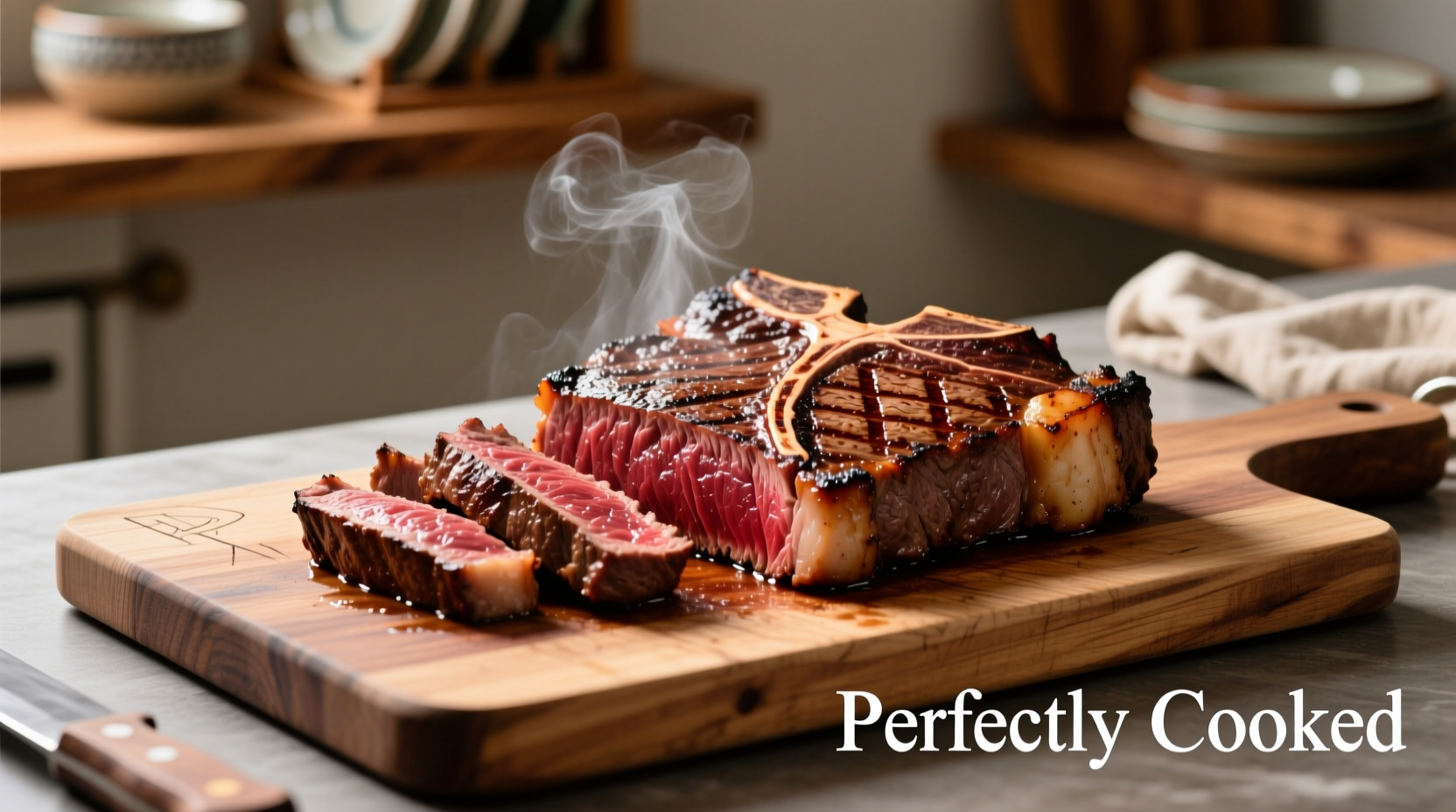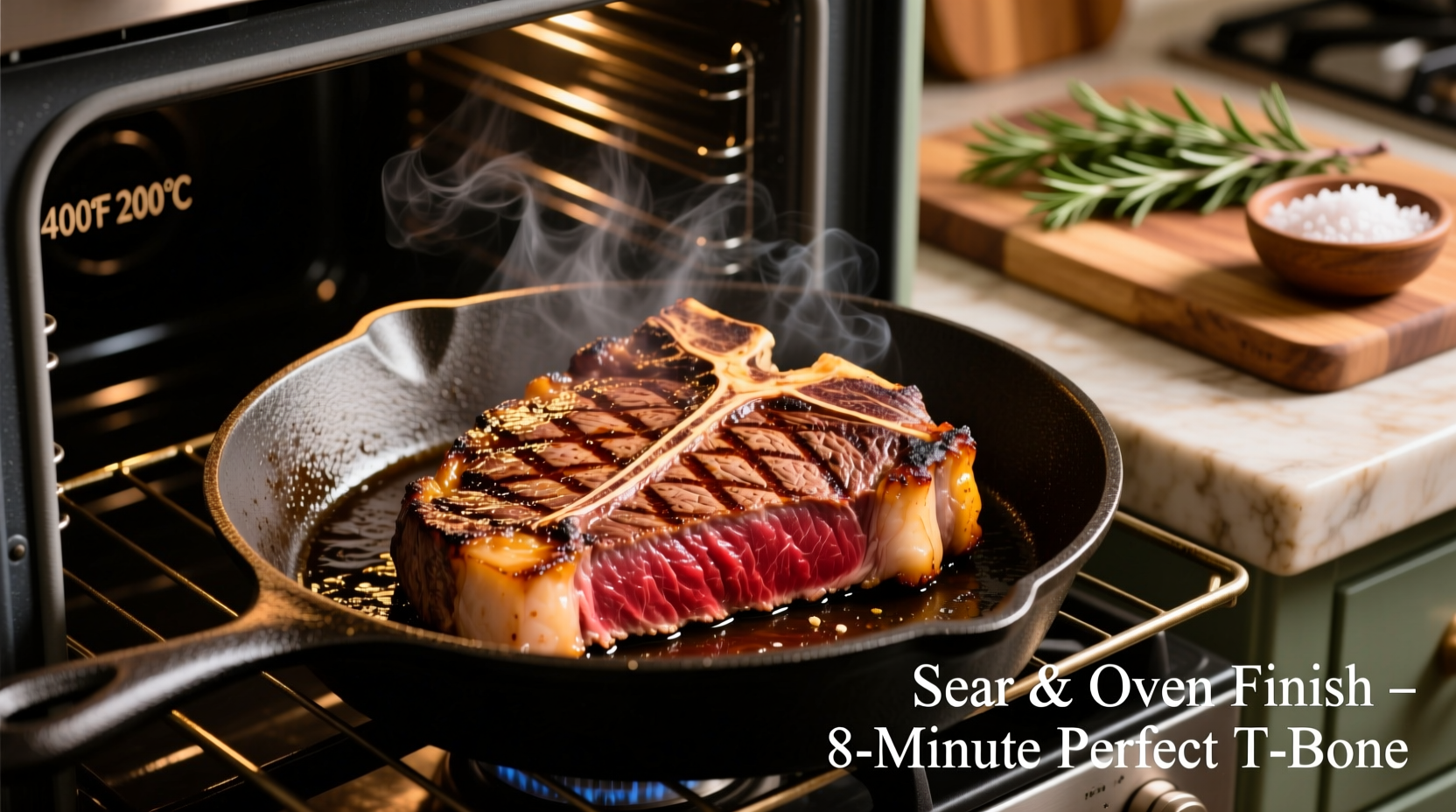The perfect method to cook a T-bone steak in the oven involves searing the steak first in a cast-iron skillet, then finishing it in a 400°F (204°C) oven for 8-12 minutes until it reaches your desired internal temperature. For medium-rare, remove at 125°F (52°C) and let rest for 10 minutes before serving.
Craving a restaurant-quality T-bone steak but don't have a grill? You're in luck. Cooking a T-bone steak in the oven produces consistently excellent results with minimal equipment. This comprehensive guide reveals the professional technique that guarantees a perfectly cooked steak with a beautiful crust and tender interior every time.
Why Oven Cooking Works Best for Thick T-Bone Steaks
Unlike thinner cuts, T-bone steaks (typically 1.5-2 inches thick) require a two-stage cooking approach. The oven provides controlled, even heat that gently cooks the interior without over-charring the exterior—a common problem with grill-only methods. This technique, favored by professional chefs, ensures your expensive cut reaches perfect doneness throughout.
Essential Equipment Checklist
Before you begin, gather these kitchen essentials:
- Heavy cast-iron or oven-safe skillet (critical for proper searing)
- Instant-read thermometer (non-negotiable for precision)
- Wire cooling rack
- Tongs (never pierce your steak!)
- Aluminum foil
Selecting the Perfect T-Bone
Not all T-bones deliver equal results. Look for these quality indicators:
- Thickness: Minimum 1.5 inches for proper oven cooking
- Marbling: Fine white fat streaks throughout the meat
- Color: Bright cherry red (avoid brownish hues)
- Freshness: Firm texture that springs back when pressed
Remember that T-bone steaks feature two muscles—the tenderloin and strip steak—separated by the T-shaped bone. This means you'll need to monitor both sections for doneness.
Step-by-Step Oven Cooking Process
Preparation: The Critical First Step
Remove your steak from the refrigerator 60-90 minutes before cooking. This crucial step ensures even cooking by bringing the meat to room temperature. Pat thoroughly dry with paper towels—moisture is the enemy of proper searing. Season generously with coarse kosher salt and freshly ground black pepper on all sides.
Searing: Creating the Flavor Foundation
Preheat your oven to 400°F (204°C). Place your cast-iron skillet over high heat until smoking hot (about 5 minutes). Add 1-2 tablespoons of high-smoke point oil (avocado or grapeseed work best). Carefully place the steak in the skillet, laying it away from you to avoid oil splatter. Sear undisturbed for 2-3 minutes until a deep brown crust forms. Flip and sear the other side for another 2-3 minutes. For maximum flavor, sear the edges by holding the steak vertically with tongs for 45-60 seconds per side.
| Doneness Level | Internal Temperature | USDA Safety Note |
|---|---|---|
| Medium-Rare | 125-130°F (52-54°C) | Recommended minimum: 145°F after resting |
| Medium | 135-140°F (57-60°C) | Safe for consumption |
| Medium-Well | 145-150°F (63-66°C) | Meets USDA minimum safety |
Source: USDA Food Safety and Inspection Service
Oven Finishing: Precision Temperature Control
Transfer the seared steak (still in the skillet) to your preheated oven. Insert an instant-read thermometer into the thickest part of the strip section (avoiding the bone). Cook for 8-12 minutes, monitoring the temperature closely. Remove when 5-10°F below your target doneness (the temperature will rise during resting). For medium-rare, this means removing at 125°F.
The Resting Period: Don't Skip This!
Place the steak on a wire rack and tent loosely with foil. Rest for 10 minutes—this allows juices to redistribute throughout the meat. Cutting too soon releases precious juices onto your cutting board instead of staying in the steak. During this time, the internal temperature will continue rising 5-10°F (the "carryover cooking" effect).

Pro Tips for Steak Perfection
- Butter baste: During the last 2 minutes of searing, add 2 tablespoons of butter, garlic cloves, and fresh herbs to the skillet. Tilt and spoon the melted butter continuously over the steak.
- Temperature accuracy: Calibrate your thermometer monthly by testing in ice water (should read 32°F/0°C).
- Even cooking: For T-bones with significantly different muscle sizes, position the larger section closer to the oven's heat source.
Troubleshooting Common Problems
Problem: Steak is overcooked on the outside but raw inside
Solution: Your oven temperature was too high or you didn't bring the steak to room temperature first.
Problem: No proper sear formed
Solution: The skillet wasn't hot enough or the steak wasn't properly dried before cooking.
Problem: Uneven cooking between tenderloin and strip sections
Solution: Position the steak with the tenderloin (smaller section) away from direct heat during oven cooking.
Why This Method Beats Grilling for Indoor Cooking
While grilling has its merits, oven finishing provides superior temperature control for thick cuts. The enclosed environment prevents moisture loss while ensuring even heat distribution—critical for a cut like T-bone with two different muscle densities. This method eliminates the guesswork that often leads to overcooked steaks when using grill-only approaches indoors.
| Cooking Stage | Time Required | Critical Action |
|---|---|---|
| Room Temperature Rest | 60-90 minutes | Dry thoroughly with paper towels |
| Searing | 4-6 minutes total | Don't move steak until crust forms |
| Oven Cooking | 8-12 minutes | Monitor temperature constantly |
| Resting | 10 minutes | Tent loosely with foil |
Final Thoughts
Cooking a T-bone steak in the oven might seem counterintuitive when you're craving that classic grilled flavor, but this professional technique delivers exceptional results with remarkable consistency. The key lies in understanding the two-stage cooking process: high-heat searing for flavor development followed by controlled oven finishing for perfect interior doneness. With proper temperature management and attention to detail, you'll achieve restaurant-quality results that will impress even the most discerning steak lovers.











 浙公网安备
33010002000092号
浙公网安备
33010002000092号 浙B2-20120091-4
浙B2-20120091-4